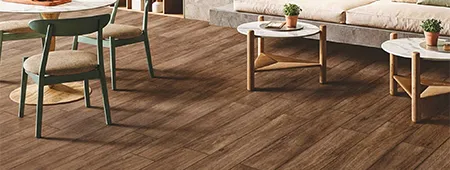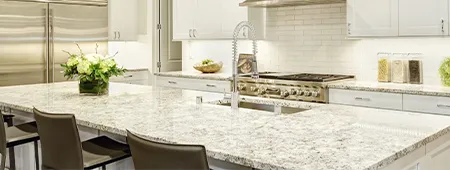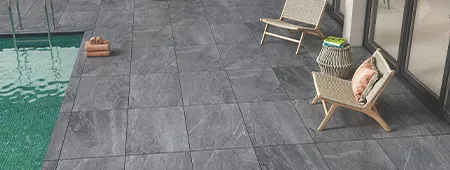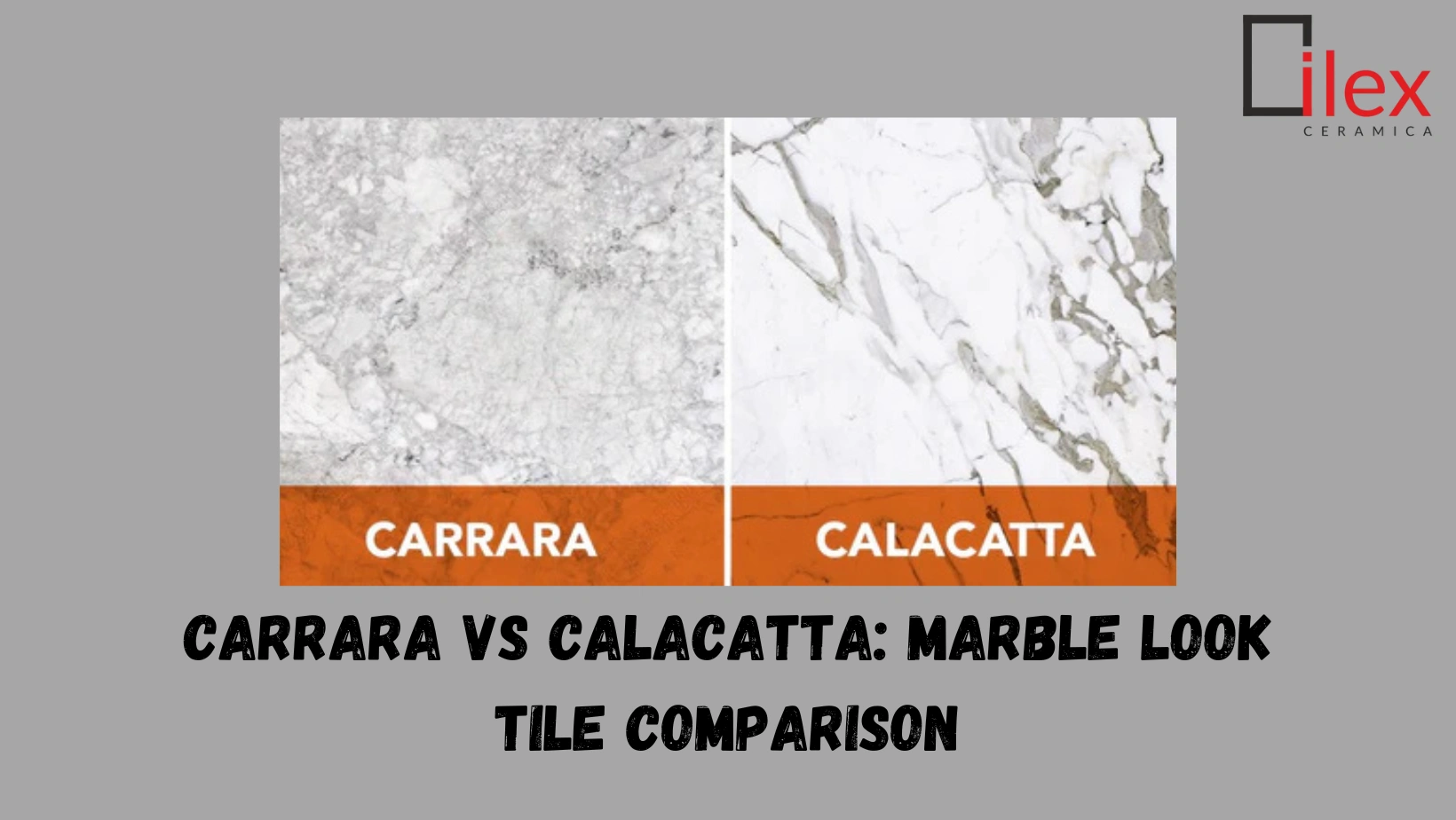01 August, 2025
Marble look tiles are an interior design disruptor, combining the vintage appeal of expensive stone tiles and practicality like never before. Two of the most popular styles, Carrara and Calacatta will suit a classic or dramatic appearance. When crafting minimal bathrooms or dramatic kitchens, it is important to know the difference between Carrara and Calacatta marble look tiles to give your project the ideal surface.
What Are Carrara and Calacatta?
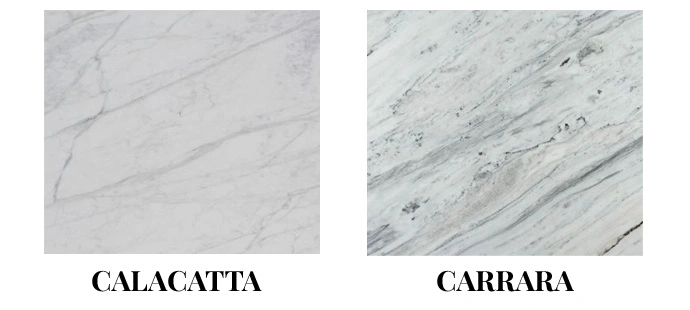
Carrara and Calacatta are both Italy marble that comes out of the most renowned marble quarries in Italy yet carry a different visual experience.
Carrara marble is known to have a soft blue grey or light grey background with alluring fine, linear veinings over it, which is widely accepted. It creates a relaxing and refined effect it is perfect in a place where subtle beauty is essential.
The Calacatta marble is distinguished by the lighter, clean, white background and dramatic, heavy-accented veining. These veins may be grey, brown, beige as well as gold, and they provide a very prominent visual appearance that can be used as feature and luxury appeal.
Although Calacatta is usually thought to be more rare and highly valued due to its uniqueness, both options have a degree of sophistication that is sought out by both homeowners and designers.
Why Marble Look Tiles?
Although natural marble is a beautiful look, it demands a lot of maintenance and etches and stains too easily. Porcelain and ceramic marble look tiles are just as beautiful as real marble but better in every aspect, including durability, maintenance, and cost. These are these tiles:
• Durable and can be used in busy places, bathrooms and kitchens.
• Stain resistant, waterproof, and scratch-resistant, they will fit well in wet places such as bathrooms and kitchens.
• Low maintenance clean with a pH cleaner or mild soap, no sealing.
• Comes in an amazing variety of sizes, finishes (matte, gloss), and colors: calacatta gold, green, blue, black, and grey marble like tiles.
Carrara vs Calacatta: What’s the Difference?
Though both are Italian marbles, there are clear distinctions in their appearance and usage:
| Feature | Carrara Marble Look Tile | Calacatta Marble Look Tile |
| Base Color | Soft, light gray, hints of blue | Bright white, sometimes creamy |
| Veining | Thin, feathery, subtle, linear | Bold, thick, high contrast, gray/gold |
| Visual Style | Subtle and Classic | Luxurious and high impact |
| Availability | Widely available | Limited and exclusive |
| Best For | Minimalist bathrooms, kitchens, floors | Feature walls, statement bathrooms, grand entries |
| Cost (tile) | Moderate to premium | Premium, especially calacatta gold |
Top Uses for Calacatta Marble Look Tiles
Feature Walls and Fireplaces: Causing a contrast and a feature from Calacatta, the strong veining design helps in making an otherwise utilitarian feature wall or fireplace into an eye-catching feature.
Luxury Master Bathrooms: Use calacatta gold or calacatta white marble effect tile on vanities, floors, or impressive walk in showers to give the feel of being in a suite in a hotel.
Luxurious Kitchens: Calacatta marble look tiles, more so gold or grey veins compliments luxurious kitchen islands, back cuts, and show organ tops.
Entering Portals: Calacatta marble appearance large format porcelain tile can create a festive entrance in foyers with elegant welcoming brilliance.
Best Applications for Carrara Marble Look Tiles
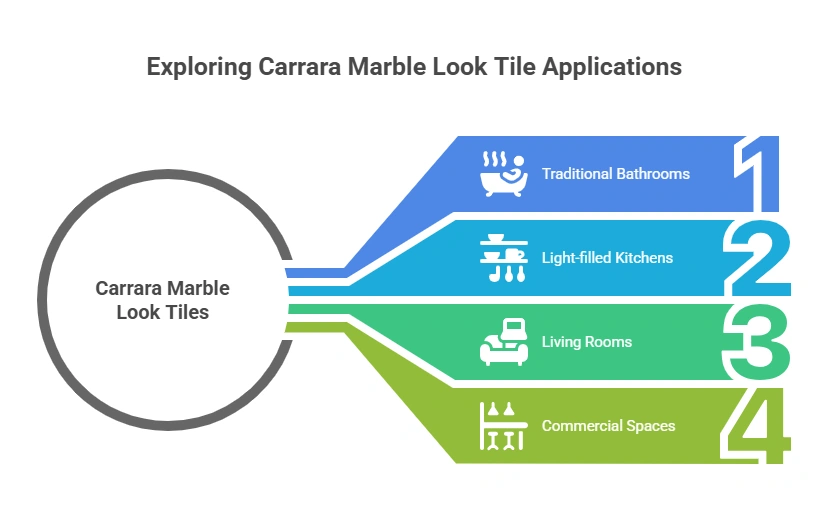
Traditional Bathrooms: Bathrooms have a timeless spa like effect crafted through Carrara with its smooth veining. Bathrooms might also be lined with Carrara marble effect tiles creating a faint luxury on bathroom walls or floors or even showers.
Light-filled kitchens: Use Carrara marble look tiles with white cabinets or contemporary fixtures to get light and fresh feeling in kitchen backsplash and flooring.
Living rooms: A modest looking floor tile made of Carrara marble makes a constrained space feel classy, and that space is your living room, hallway, or any entryway, particularly so in an open concept that seeks visual stability.
Commercial Spaces: Carrara lends a professional, untarnished look that is suitable in an office, a beauty salon or a retail store seeking a minimalistic look.
Specialty and Creative Applications
Color Variants for Contemporary Flair: Blue marble effect tiles, black marble effect tiles, and green marble effect tiles allow designers to break tradition, introducing bold or eclectic ambiance in bedrooms, powder rooms, or boutique retail.
Mixed Patterns and Layouts: Combine mosaic or herringbone patterns of marble effect vitrified tiles to add texture and movement, perfect for artistic bathroom floors or creative wall features.
Large Format Tiles for Seamless Spaces: Eternal calacatta gold or other large format options minimize grout lines, amplifying the sleek marble look in expansive rooms or open designs.
Design Tips for Choosing and Using Marble Look Tiles
Matte vs Gloss: Matte finishes better hide water spots and slips for bathrooms or busy kitchens, while gloss finishes boost brightness and reflectivity for smaller or darker spaces.
Size and Layout: Larger tiles reduce seams and make rooms feel bigger; smaller tiles or mosaics can be used as accents or shower niches for added detail.
Pairing with Other Materials: For modern contrast, combine marble look tiles with wood, black metal, or colored cabinets.
Why Choose Marble Look Porcelain Tile Over Real Marble?
Porcelain tiles offer several advantages over natural marble:
• Non-porous surface: Resistant to water, stains, and bacteria
• Minimal upkeep: No sealing or polishing needed
• Durability: Great for high traffic areas like hallways or kitchens
• Eco-friendly: Lower carbon footprint than quarrying natural stone
• Budget-friendly: Achieve a high end look without the premium price
For example, marble look floor tile in a Calacatta design can mimic the rich veining of real stone at a fraction of the cost.
Carrara and Calacatta Marble Look Tile
Conclusion
When it comes to elevating interiors, marble look tile offers the natural beauty of Italian stone with modern performance. Choose Carrara for soft elegance that blends seamlessly with classic, minimalist, or contemporary designs. Opt for Calacatta when you want a striking, dramatic centerpiece especially in luxury kitchens, grand entryways, or spa inspired bathrooms.
No matter your style, today’s marble effect tiles, including porcelain and ceramic provide an array of colors, patterns, and finishes to bring timeless sophistication and maximum practicality to every room. Matching aesthetics with durability has never been easier or more beautiful.
FAQs
1. What is a good alternative to Calacatta marble?
A great alternative to Calacatta marble is Calacatta marble look porcelain tile. It replicates the bold veining and white base of real Calacatta at a more affordable price, with better durability and lower maintenance. Quartz and marble effect ceramic tiles also offer similar aesthetics for budget conscious projects.
2. Is Carrara or Calacatta better?
It depends on the design goal. Carrara is more subtle and ideal for minimalist or classic interiors, while Calacatta offers bold veining and a brighter white background, making it perfect for luxurious, high impact spaces. Both are beautiful, your choice should reflect the desired style and budget.
3. Is Carrara or Calacatta more expensive?
Calacatta is generally more expensive than Carrara due to its rarity and dramatic veining. Carrara is more abundant and typically costs less, making it a popular choice for those seeking a marble finish on a tighter budget.
4. What stone looks like marble but is cheaper?
Porcelain tiles, ceramic tiles, and quartz are popular stones that look like marble but are more affordable. Marble look floor tiles and marble effect wall tiles offer the same visual appeal as natural marble without the high cost and upkeep.
5. Why is Calacatta so expensive?
Calacatta marble is expensive because of its rarity, exclusive quarry locations in Italy, and its unique, bold veining patterns. Each slab is distinct, making it a luxury material often used in upscale interiors and designer projects.
6. What is the most popular Calacatta marble?
One of the most sought after varieties is Calacatta Gold, known for its luxurious golden veining and warm tones. Eternal Calacatta Gold, available in marble look porcelain tiles, is also extremely popular in modern interiors for its rich contrast and timeless elegance.
7. Is Calacatta marble from India?
No, authentic Calacatta marble originates from Carrara, Italy, and is quarried in specific regions. However, Calacatta inspired stones and tiles are manufactured in India and other countries, offering more affordable alternatives to the original Italian marble.
8. Why is Carrara marble so special?
Carrara marble is valued for its history, timeless beauty, and soft veining. It has been used in art and architecture since ancient Rome. Its availability, versatility, and ability to blend with many design styles make it a staple in both classic and contemporary interiors.

